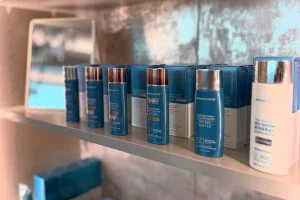
Let’s be honest. The bathroom shelf can become a graveyard of half-used potions and plastic bottles. It’s a cycle of consumption that feels… well, wasteful. But what if your skincare routine could actually be good for the planet, too?
Sustainable and zero-waste skincare isn’t about perfection. It’s a mindset shift. It’s about making conscious choices that reduce your environmental footprint while still giving your skin the love it deserves. It’s a slower, more thoughtful approach to beauty. And honestly? It feels fantastic.
Why Your Skincare Routine Has an Environmental Impact
Every product we buy has a backstory. The journey from raw ingredients to your face involves water, energy, and packaging—lots of it. Most skincare containers are made from mixed materials that are notoriously difficult to recycle. They end up in landfills or, worse, our oceans.
Then there’s the product itself. The chemicals in some conventional products can wash down our drains, impacting aquatic life. A zero-waste skincare routine aims to tackle this from both angles: what’s inside the bottle and the bottle itself.
The Core Principles of a Low-Waste Routine
You don’t need to overhaul everything overnight. Start here. Think of these as the guiding stars for your new routine.
1. Refuse, Reduce, Reuse, Recycle (In That Order!)
You know the mantra. For skincare, it’s golden. First, refuse what you don’t need—like single-use wipes or free samples that will just clutter your space. Next, reduce the number of products you use. Do you really need a 10-step routine? Probably not. Then, reuse containers where possible. And finally, recycle properly as a last resort.
2. Prioritize Packaging
This is a big one. Seek out:
- Glass jars and bottles: Infinitely recyclable and feel lovely in the hand.
- Aluminum tins: Also highly recyclable, great for balms and solid products.
- Refillable systems: More and more brands are offering refill pouches you can pour into your original, beautiful container.
- Compostable or paper packaging: Ideal for bar soaps and other solid items.
3. Know Your Ingredients
Sustainable skincare is as much about what’s inside as what’s outside. Look for biodegradable formulas and plant-based ingredients. Be wary of “natural” buzzwords, though. The goal is to support brands that are transparent about their sourcing.
Building Your Routine, Step-by-Step
Okay, let’s get practical. Here’s how to build a simple, effective, and low-waste regimen from cleanse to moisturize.
Cleanse: The Solid Bar Revolution
Forget the plastic pump bottle. Solid cleansing bars are the undisputed champions of package-free skincare. They’ve evolved far beyond the harsh soaps of yesteryear. You can now find gentle, pH-balanced facial bars for every skin type—oily, dry, sensitive, you name it.
They last for ages, travel without liquid restrictions, and often come in a simple paper box. A win-win-win.
Tone: DIY or Concentrates
Toners are tricky because they’re mostly water shipped in a heavy bottle. One fantastic alternative is using a concentrate. You get a small glass vial of active ingredients and mix it with water in a reusable spray bottle at home.
Or, you know, you can explore a simple DIY toner with rosewater or green tea. It’s simpler than it sounds.
Treat: Serums and Oils in Glass
This is where treatment comes in. Serums and facial oils are typically already housed in dark glass bottles to protect the active ingredients. This is great! Just ensure the brand uses glass droppers or pumps, and maybe even offers a refill program.
Focus on multi-tasking ingredients. A rosehip oil, for instance, can tackle dryness, brighten, and support skin texture all at once.
Moisturize: Back to the Jar (The Right Way)
Moisturizer is another easy swap. Look for creams and lotions in glass jars or metal tins. Sure, there’s a debate about jars and preservatives, but many sustainable skincare brands use effective, natural preservation systems that keep the product stable.
Another brilliant option? Solid moisturizer bars. They look like a balm and you warm a small amount between your fingers to apply. They’re incredibly rich and perfect for night-time use.
Beyond the Basics: Other Swaps to Consider
The rabbit hole goes deep, and it’s full of clever, low-waste alternatives.
- Reusable Cotton Rounds: This is a no-brainer. Ditch the disposable cotton balls and pads for soft, washable cloth rounds. They’re kinder to your skin and the planet.
- Toothpaste Tablets & Bamboo Toothbrushes: While not strictly skincare, oral care is part of the bathroom waste problem. Tablets come in glass jars and bamboo brushes compost handle and all.
- DIY Face Masks: A spoon of honey, a little oatmeal, some yogurt… your kitchen is a treasure trove of simple, effective, and fun masking ingredients.
What to Do With Your Old Products
Transitioning doesn’t mean throwing everything out. That would be, well, wasteful. Use up what you have first. When you’re done, get creative.
| Product Type | How to Repurpose or Dispose |
| Plastic Pump Bottles | Clean thoroughly and see if a local refillery will take them. Otherwise, check local recycling rules. |
| Glass Jars with Lids | Perfect for DIY projects, storing small items, or as tiny plant pots. Clean and reuse endlessly. |
| Almost-Empty Serums | Add a few drops of distilled water to get the last bits out, or use the residue on your body. |
The Final Word: Progress, Not Perfection
Adopting a sustainable beauty routine is a journey of small steps. It’s not about achieving some impossible standard of zero-waste purity. It’s about one less plastic bottle in the trash. One conscious purchase. One moment of asking, “Do I really need this?”
That collective shift in thinking—that’s what creates real change. Your skin will thank you. And so will the planet. Now that’s a beautiful thought.








